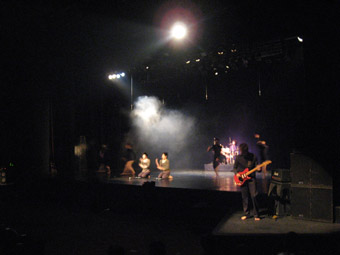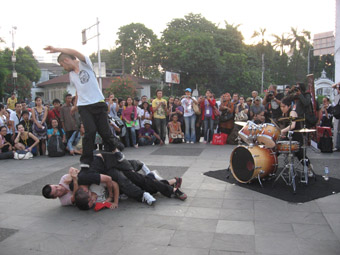 |
Darkness Poomba photo Phalla San |
As the house lights dimmed and the curtains parted, we saw an electric guitar and bass on either side of the front of the stage, and upstage centre a drum set—to the delight of many dance audiences who prefer live to canned music. No musicians though. As two dancers moved downstage centre, we became aware of a singer behind a microphone in the house right aisle. The lyrics were in Korean, we thought, and that’s when some of us couldn’t help ignoring them, despite the singer’s vivacious hand gestures. And so music might suddenly become noise. Later on, the musicians took their places and, for a brief moment, the dancers stopped moving, giving the focus to the music.
Most of the time, though, the performance was multi-focus, attempting as it did to involve the audience—one dancer came down from the stage and up the house right aisle to sing and play instruments, while another two used the left aisle as their main stage. We were encouraged by the performers to clap along, and many of us did, and that’s perhaps when we felt we might have forgotten some dance-going etiquette. Then again, such restraint was established by Western classical ballet companies, and this is Korean contemporary dance.
Darkness Poomba is an example of how a unique intra-cultural experiment has led to engaging contemporary performance. This is thanks, in major part, to the fact that the choreographer and composer Kim Jae Duk has found, and emphasized, links between contemporary dance and an ancient singing tradition, Poomba—in which rhythm plays a stronger role than lyrics which, as a Korean tourism website explains, don't mean anything. Although the performance was explained in the festival’s printed program as “composed of 70% of dance and 30% of music”, the union of the two was such that it became “100% of contemporary performance” which reminded us of the relationship between dance and music, and how artists have been trained concurrently in many disciplines thoughout the history of many performing arts traditions.
It’s perhaps also another reminder that although many Asian contemporary choreographers look to European and American counterparts, sometimes they can just look back to, and 're-search,' their past. It may also be confirmation that although 'modern' equates with Western in many Asian countries, 'contemporary' is totally different.
Presented at an international festival, Darkness Poomba may also trigger our curiosity about the Poomba tradition. As the tourism website suggests, we can visit the National Pumba Festival every year in the town of Eumseong, to see and hear how the actual traditional street performance with funny make-up and costumes, or Lightness Poomba if you will, lifted up Korean spirits in poverty-stricken times.
 |
Contact Gonzo and Sayaka Himeno, public space photo Phalla San |
Of course, many of us are still delighted to see contemporary dance works set to European classical music played to a live audience on CD, but, as a connotation of the term 'contemporary' suggests, there are also many other possibilities. After all, unlike theatre which is usually associated with, and powered by, spoken word that limits overseas exposure, contemporary dance speaks with body movements and music, or, as in these two cases, noise.
10th Indonesian Dance Festival: Kim Jae Duk Project, Darkness Poomba, choreographer, composer, dancer, musician Kim Jae Duk, with dancers and musicians; Graha Bhakti Sudaya, June 14; contact Gonzo and Sayaka Himeno, public space, Graha Bhakti Sudaya, Taman Ismail Marzuki, Jakarta, June 14
© Pawit Mahasarinand; for permission to reproduce apply to [email protected]








 back
back